
CHAZEL HAKIM – MARCH 11TH, 2021
EDITOR: KAT XIE
Two years ago, the president of Indonesia, Joko “Jowoki” Widodo, announced a grandiose plan. Motivated by problems plaguing Indonesia’s current capital, Jakarta, Widodo decided on a new initiative to relocate the country’s administration out of the island of Java northward to the island of Kalimantan. In fact, the president not only planned to move the capital out of Indonesia, but he even wanted to build the city from scratch, with construction beginning just a year later in 2020. Jakarta, on the other hand, was to remain Indonesia’s economic and business center.
Now in 2021, after a year scarred by the COVID-19 virus, Widodo still remains determined to conduct the massive development project despite severe setbacks for Indonesia from the pandemic. It appears that, even if Indonesia’s economy looks drastically different than it did in 2019, the new capital still stands as a top priority for the current administration. The only noticeable change to the plan now seems to be the starting date of the project, which has been moved to 2022 after the country plans to complete its vaccination program.
Given that Indonesia decided to move forward with the project, one might wonder whether the country will actually be able to pull off such a massive feat. Many have already questioned whether it was a worthwhile mission for the Indonesian government to pursue considering the costs. But despite the potential for failure, Widodo’s plan may be beneficial for the country, especially given the environmental problems currently inflicting its capital city.
Trouble in Jakarta
Most of the motivation for the decision to move Indonesia’s capital to another island originates from its current capital, Jakarta. Since the fourth century, Jakarta has played a pivotal role around the Southeast Asian archipelago, starting out as an important trading port but later becoming the capital city of both the Dutch East Indies and the country of Indonesia. Nowadays it serves as the economic and political center of Indonesia, housing more than 10.77 million Indonesians and more who come looking for opportunities to work.
Such centralization in one city does not come without a price. Traffic congestion and air pollution are just two related problems that the city faces as a result of its population growth. In 2015, the Castrol Stop-Start Index ranked Jakarta as the city with the most stop-starts while driving, implying that it had the worst traffic congestion in the world. The number of motor vehicles used on the road has indeed jumped from two million in 2010 to over four million in 2018, and increased vehicle emissions—combined with other emissions in the city (coal, household, etc.)—have in turn caused a severe decline in Jakarta’s air quality.
Yet perhaps the most important motivation to move out of the city is a problem currently making headlines in several news outlets: Jakarta is sinking fast into the ground. The science behind the issue, dubbed “land subsidence,” is not complicated. Since piped water is not readily available for the majority of the population, many have resorted to pumping the water from aquifers deep underground in the city. As a result, the aquifers have shrunk as pumping becomes more excessive, which has caused Jakarta to slowly go down as if it sits on a deflating balloon.
Areas ranging from Bangkok and Nigeria to California’s central valley are also experiencing land subsidence, but the issue is particularly thorny for Jakarta. As a coastal city on swampy land, the city’s north side is prone to flooding, and some models predict that land subsidence could cause the flooding to reach several kilometers inland by 2050. The effects of climate change will just complicate the problem furthermore, as Jakarta will be hit by both rising sea levels as a coastal city and increased rainfall in its tropical location. If no substantial action is taken to combat the problem, it is estimated that North Jakarta will be submerged underwater by 2100 (Figure 1).

Figure 1: Sea level rise projections by 2100 for two scenarios with the amount of rise in meters indicated (mild = 3m; extreme = 5m). Percentage and total population displacement indicated bottom right.
Image source: Earth.org
Man with a Plan
Enter the potential solution: President Joko Widodo. Currently on his second and last term as president, Widodo has not been adverse to ambitious infrastructure missions for his country. He had already completed a variety of achievements in his first term alone, ranging from constructing Jakarta’s first transit system to building new toll roads all around the country. It is no wonder that the president decided to step up his ambitions in his second term, among which include the capital relocation plan.
It is easy to be skeptical of the move’s necessity. Some may ask why Widodo’s administration doesn’t double down on infrastructural solutions for Jakarta instead of moving elsewhere. After all, estimates for the costs of building the new city total more than 33 billion US dollars, which is a budget that could be spent on the projects intended to save Jakarta. Others even argue that the move is an act of abandonment. Given the controversial attempts to fix the city’s problems, one that includes building a massive bird-shaped seawall across North Jakarta, it may appear that the best solution for the government at this point is to re-establish authority in another, safer area.
According to President Widodo, however, the plan stems beyond Jakarta’s environmental concerns. Though most news headlines might pinpoint the cause of the relocation just to Jakarta’s sinking issue, Widodo has claimed in an interview that moving the capital elsewhere has been on the agenda since the first president of Indonesia took office in 1945. “[Presidents] wanted to relocate the capital out of Java,” he states, “because 150,000 million people are in Java, but we have 17,000 islands . . . We need to distribute the population and economy to other islands.” The location of the new capital is even an extension of his point: it is strategically located both outside of Java and in the center of Indonesia’s many islands, which can be seen as a symbolic shift towards a new, more decentralized Indonesia (Figure 2).

Figure 2: Compared to Jakarta in the Southwest, the location of the new capital sits nearer to the center of Indonesia.
Image source: The Asean Post
In this sense, the plan can be beneficial for Indonesia’s growth. The island of Java already accounts for 58% of the country’s total GDP, and the island Widodo wants to move the capital to, Kalimantan, only contributes to 8% of GDP despite being four times larger than Java. By building the capital outside Java, Widodo could potentially spread the country’s wealth and job opportunities to other islands. Research on economic decentralization in Indonesia supports this notion, arguing that regional development has reduced inequality and poverty in the past. Moreover, the Indonesian government’s image for non-Javanese Indonesians could also improve considering reports that the country has been too “Java-centric” in its economic development.
The Virus Disrupts
Despite the potential both for disaster evasion and decentralized growth, the question still remains on whether Indonesia will even be able to build the new city. The most pressing issue in this respect is the COVID-19 virus. After the pandemic started, Indonesians experienced their first recession since 1998 as GDP shrank by 2% in Q1, but it isn’t necessarily the funding for the project’s $33 billion bill that will be severely impacted. Indonesia already planned to rely mostly on private, foreign investors to support the feat, and these plans have not seemed to change even after the pandemic started.
Rather, the pandemic impacts the issue of time, specifically for Widodo. Plans for the city’s construction were originally scheduled in 2019 for 2020 to 2024, ending right on the year he had to leave office. Yet the pandemic has stalled the construction schedule by pushing it forward to March 2022 at the earliest. More specifically, the city’s starting construction date is timed for when the country finishes its vaccination program, but given the Indonesian government’s dismal response to the pandemic, it is unsure whether or not vaccination will be completed by then. Widodo, on the other hand, is on a fixed schedule in his final term as president.
Why does this matter? The answer is more about politics than economics. After a string of corrupt presidents in Indonesia’s history, Widodo became widely popular to Indonesians for his defining trait as a clean and common politician. His aversion to corruption, at least compared to his predecessors, has helped him to pursue infrastructure projects to completion without any funding controversies surrounding them. For example, while it took his predecessor 10 years just to build 229 kilometers of new tolls roads, Widodo was able to direct the construction of 718 kilometers around Indonesia in only three years.
It is uncertain whether the president succeeding Widodo can complete the project if it isn’t nearly finished by 2024. Considering both the size of the plan as well as the fact that private investors are heavily involved, one should expect that only a president as competent as Widodo would be able to lead the project to completion. This fear of failure, coupled with the belief that starting construction would revive Indonesia’s economy faster, may help explain why the president’s administration is determined to complete the project despite slowdowns from the pandemic.
Future Considerations
Other than time, Widodo’s administration will have to deal with other issues as well. Perhaps most ironic is the fact that he already faces environmental challenges in the new capital, as the planned location in Kalimantan is currently situated in a forest that needs deforestation before construction. Consequently, Widodo’s administration has announced that the new city would be developed in a sustainable manner, though to what extent this would counter the effects of the deforestation beforehand is questionable.
Indonesia may be lucky in the broader perspective though. If all construction in the coming years goes as planned, Widodo will have both successfully redirected the country’s administrative center away from the crisis in Jakarta and potentially decentralized the economic power held by Java. This would be a win-win situation for all Indonesians, though it is not hard to surmise that the local government in Jakarta might say otherwise. Moving the capital out of Jakarta does not solve Jakarta’s problems, but at the bare minimum, at least the country will be able to govern itself and plan a solution elsewhere.
On a broader note, perhaps it is more important that other countries consider the predicament Indonesia faces and how their president chose to respond. After all, these countries might find themselves having to deal with the same problems in the future, and the effects of climate change—rising sea levels, harsher weather, frequent droughts—will not make dealing with them any easier. In this regard, Indonesia will hopefully be able to serve as an example on how to adapt to these changes, as ultimately, the country will not be the only one to have to face them.
Featured Image Source: Reuters
Disclaimer: The views published in this journal are those of the individual authors or speakers and do not necessarily reflect the position or policy of Berkeley Economic Review staff, the Undergraduate Economics Association, the UC Berkeley Economics Department and faculty, or the University of California, Berkeley in general.


